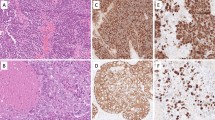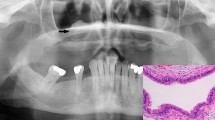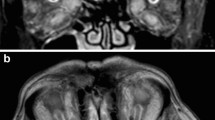Summary
Background
Solitary fibrous tumor (SFT) is a rare spindle-cell benign neoplasm and located in orbit. The present research represents case reports of ten patients with orbital SFT.
Method
Prognosis was assessed by clinic service and telephone interview. Clinical data were retrieved from the medical records. Immunohistochemistry for CD34, CD99, EMA, HMB-45, Bcl-2, GFAP, S-100, MBP, CK, and MIB-1 was performed. Distributions of time to progression and recurrence between different operative methods were estimated using the Kaplan-Meier method and compared using the log-rank test.
Findings
The ten patients included six men and four women (range: 19–75 years). The most common initial symptom was painless proptosis (n = 6). After the ten initial surgeries, with four requiring gross total resection (GRT) and six requiring subtotal resection (STR), an additional nine were required to remove recurrent tumors. Eighteen samples were obtained for pathological examination (the third sample for case 4 was not achieved). Cellular areas with partial hemangiopericytoma pattern were noted in four samples (4/18); scarce mitosis was noted in six samples (6/18). All SFTs (18/18) were positive for CD34, CD99 and vimentin, while all SFTs (18/18) were negative for EMA, CK, MBP, HBM-45 and GFAP. Bcl-2 was positive in 13/18 cases, while S-100 was negative in 14/18 cases. The MIB-1 labeling index varied from 1% to 3%. Follow-up was available for nine patients with a median of 88 months. All four patients who underwent GTR on initial operation did not recur; while the five patients who underwent STR recurred. The log-rank test showed that the incomplete surgical resection was significantly associated with recurrence (p = 0.015).
Conclusions
Orbital SFT is a rare mesenchymal tumor and painless proptosis is the most common initial symptom. Immunohistochemistry should be used to differentiate SFT from other tumors. Orbital SFT usually has a non-aggressive histological characteristic, and has a good prognosis if GTR is performed. Postoperative regular and long-term follow-up remains mandatory to monitor recurrence.




Similar content being viewed by others
References
Alexandrakis G, Johnson TE (2000) Recurrent orbital solitary fibrous tumor in a 14-year-old girl. Am J Ophthalmol 130:373–376
Ali SZ, Hoon V, Hoda S, Heelan R, Zakowski MF (1997) Solitary fibrous tumor. A cytologic-histologic study with clinical, radiologic, and immunohistochemical correlations. Cancer 81:116–121
Bernardini FP, de Conciliis C, Schneider S, Kersten RC, Kulwin DR (2003) Solitary fibrous tumor of the orbit: is it rare? Report of a case series and review of the literature. Ophthalmology 110:1442–1448
Carrera M, Prat J, Quintana M (2001) Malignant solitary fibrous tumour of the orbit: report of a case with 8 years follow-up. Eye (Lond) 15:102–104
Cummings TJ, Burchette JL, McLendon RE (2001) CD34 and dural fibroblasts: the relationship to solitary fibrous tumor and meningioma. Acta Neuropathol 102:349–354
England DM, Hochholzer L, McCarthy MJ (1989) Localized benign and malignant fibrous tumors of the pleura. A clinicopathologic review of 223 cases. Am J Surg Pathol 13:640–658
Feuerman JM, Flint A, Elner VM (2010) Cystic solitary fibrous tumor of the orbit. Arch Ophthalmol 128:385–387
Furusato E, Valenzuela IA, Fanburg-Smith JC, Auerbach A, Furusato B, Cameron JD, Rushing EJ (2011) Orbital solitary fibrous tumor: encompassing terminology for hemangiopericytoma, giant cell angiofibroma, and fibrous histiocytoma of the orbit: reappraisal of 41 cases. Hum Pathol 42:120–128
Gengler C, Guillou L (2006) Solitary fibrous tumour and haemangiopericytoma: evolution of a concept. Histopathology 48:63–74
Girnita L, Sahlin S, Orrego A, Seregard S (2009) Malignant solitary fibrous tumour of the orbit. Acta Ophthalmol 87:464–467
Hayashi S, Kurihara H, Hirato J, Sasaki T (2001) Solitary fibrous tumor of the orbit with extraorbital extension: case report. Neurosurgery 49:1241–1245
Kim HJ, Kim YD, Yim YJ, Kim ST, Jeon P, Kim KH, Byun HS, Song HJ (2008) Solitary fibrous tumor of the orbit: CT and MR imaging findings. AJNR Am J Neuroradiol 29:857–862
Klemperer P, Rabin CB (1931) Primary neoplasms of the pleura: a report of five cases. Arch Pathol 11:385–412
Krishnakumar S, Subramanian N, Mohan ER, Mahesh L, Biswas J, Rao NA (2003) Solitary fibrous tumor of the orbit: a clinicopathologic study of six cases with review of the literature. Surv Ophthalmol 48:544–554
Leoncini G, Maio V, Puccioni M, Franchi A, De Giorgi V, Ucci F, Santucci M, Massi D (2008) Orbital solitary fibrous tumor: a case report and review of the literature. Pathol Oncol Res 14:213–217
Metellus P, Bouvier C, Guyotat J, Fuentes S, Jouvet A, Vasiljevic A, Giorgi R, Dufour H, Grisoli F, Figarella-Branger D (2007) Solitary fibrous tumors of the central nervous system: clinicopathological and therapeutic considerations of 18 cases. Neurosurgery 60:715–722, discussion 722
Nakahara K, Yamada M, Shimizu S, Fujii K (2006) Stereotactic radiosurgery as adjuvant treatment for residual solitary fibrous tumor. Case report. J Neurosurg 105:775–776
Polito E, Tosi M, Toti P, Schurfeld K, Caporossi A (2002) Orbital solitary fibrous tumor with aggressive behaviorThree cases and review of the literature. Graefes Arch Clin Exp Ophthalmol 240:570–574
Romer M, Bode B, Schuknecht B, Schmid S, Holzmann D (2005) Solitary fibrous tumor of the orbit–two cases and a review of the literature. Eur Arch Otorhinolaryngol 262:81–88
Scott IU, Tanenbaum M, Rubin D, Lores E (1996) Solitary fibrous tumor of the lacrimal gland fossa. Ophthalmology 103:1613–1618
Tam ES, Chen EC, Nijhawan N, Harvey JT, Howarth D, Oestreicher JH (2008) Solitary fibrous tumor of the orbit: a case series. Orbit 27:426–431
Tihan T, Viglione M, Rosenblum MK, Olivi A, Burger PC (2003) Solitary fibrous tumors in the central nervous system. A clinicopathologic review of 18 cases and comparison to meningeal hemangiopericytomas. Arch Pathol Lab Med 127:432–439
Welling LC, Lynch JC, Ferreira LA, Correa JB, Sapunaru M, Cortezzi W, Schulz R (2009) Solitary fibrous tumor with intracranial invasion. Arq Neuropsiquiatr 67:701–703
Westra WH, Gerald WL, Rosai J (1994) Solitary fibrous tumor. Consistent CD34 immunoreactivity and occurrence in the orbit. Am J Surg Pathol 18:992–998
Yin W, Ma C, Wu J, Cai B, You C (2010) A primary atypical solitary fibrous tumor of the sella mimicking nonfunctional pituitary adenoma: a case report. Acta Neurochir (Wien) 152:519–522
Acknowledgements
We thank professor Jian-Kang Shen for expert opinions during the development of this manuscript. We also thank Ya-Xuan Wang for collecting data. This work was supported by grants from Shanghai Leading Academic Discipline Project (S30205) and Shanghai Science and Technology Committee Major Program Project (10411964000).
Conflicts of interest
None.
Author information
Authors and Affiliations
Corresponding authors
Additional information
Comment
Neurosurgery at Huashan Hospital, Shanghai, is at its own level of magnitude—for example, 6,700 meningiomas, 183 hemangiopericytomas and 28 solitary fibrous tumors (SRTs) of the central nervous system (CNS) operated on in a 9-year period (2002–10). The authors report ten cases of solitary fibrous tumour (SFT) of the orbital cavity. Orbital SFT is so rare that this reviewer encountered none in 30 years—but the authors rightly point out that SFTs have been underdiagnosed. China and its megacities allow the creation of huge neurosurgical units compared with our European ones, and such units may produce neurosurgical series much larger than published from Europe.
Lessons for researchers of clinical neuro-oncology in Europe?
1. National and international CNS tumor series rather than single-center ones.
2. Comparison of long-term outcome with that of matched catchment populations—double almost exclusively in Europe.
Juha E Jääskeläinen
Kuopio Finland
1. Vassal F, Manet R, Forest F, Camdessanche JP, Péoc’h M, Nuti C (2011) Solitary fibrous tumors of the central nervous system: report of five cases with unusual clinicopathological and outcome patterns. Acta Neurochir (Wein) 153:377–384
Hong Chen and Cai-Wen Xiao contributed equally to this work
Rights and permissions
About this article
Cite this article
Chen, H., Xiao, CW., Wang, T. et al. Orbital solitary fibrous tumor: a clinicopathologic study of ten cases with long-term follow-up. Acta Neurochir 154, 249–255 (2012). https://doi.org/10.1007/s00701-011-1254-4
Received:
Accepted:
Published:
Issue Date:
DOI: https://doi.org/10.1007/s00701-011-1254-4




